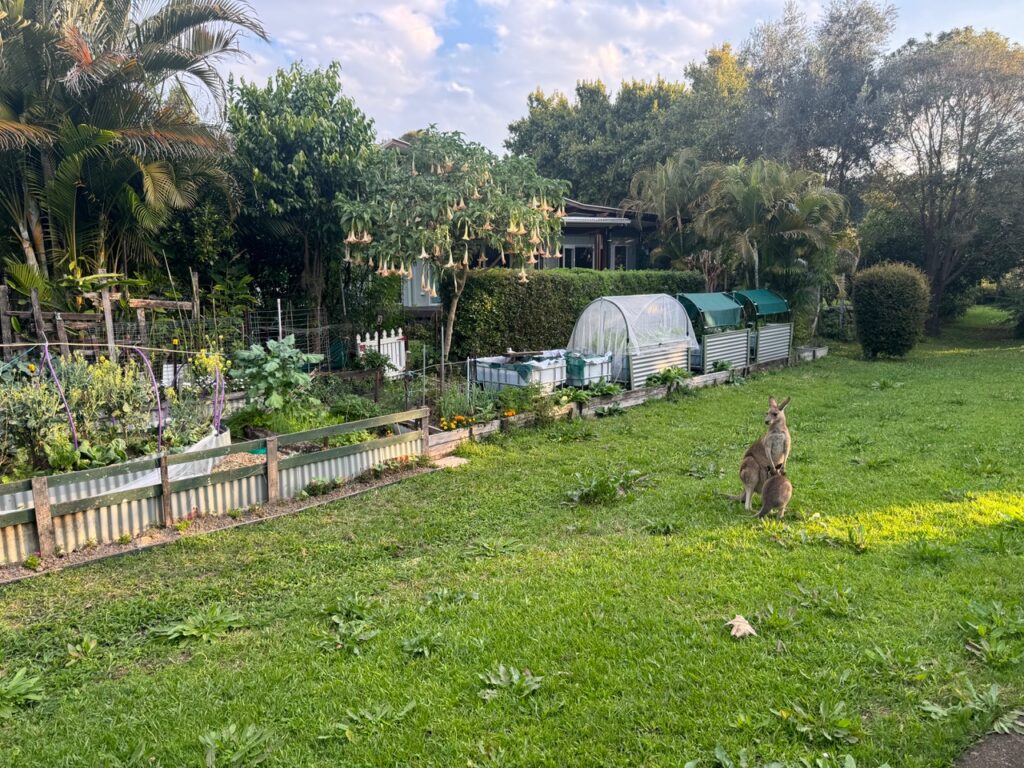Shelle and I had a wonderful working holiday in the Northern Rivers Region of NSW during the second half of August. It’s become an annual trip since our daughter, Amala, moved there 4yrs ago. We’ve fortunately been able to combine each trip with some consulting work there, including being the key-note speaker at Byron Bay’s affordable regional housing summit in 2022. This year we were able to provide advice to a new ecovillage project that’s getting underway in Kyogle, as well as spend some time having a close look at the Currumbin Ecovillage and visiting a range of Bath Houses in the region, which we have been exploring for our potential Ecovillage Bath House project – hard work, I know, but someone has to do it!
It’s such a magnificent region, with volcanic soils and an average annual rainfall of between 1200-1500mm, varying from town to town (south to north). Though, as we all remember, it can exceed 2500mm in extreme years!
We flew from Perth to Brisbane, where we hired a BYD EV. There’s great deals associated with hiring EV’s, including free charging at all ChargeFox stations, so it’s a great way to try different EV’s. We were very impressed with the BYD Atto 3, which was very comfortable, efficient and enjoyable to drive.
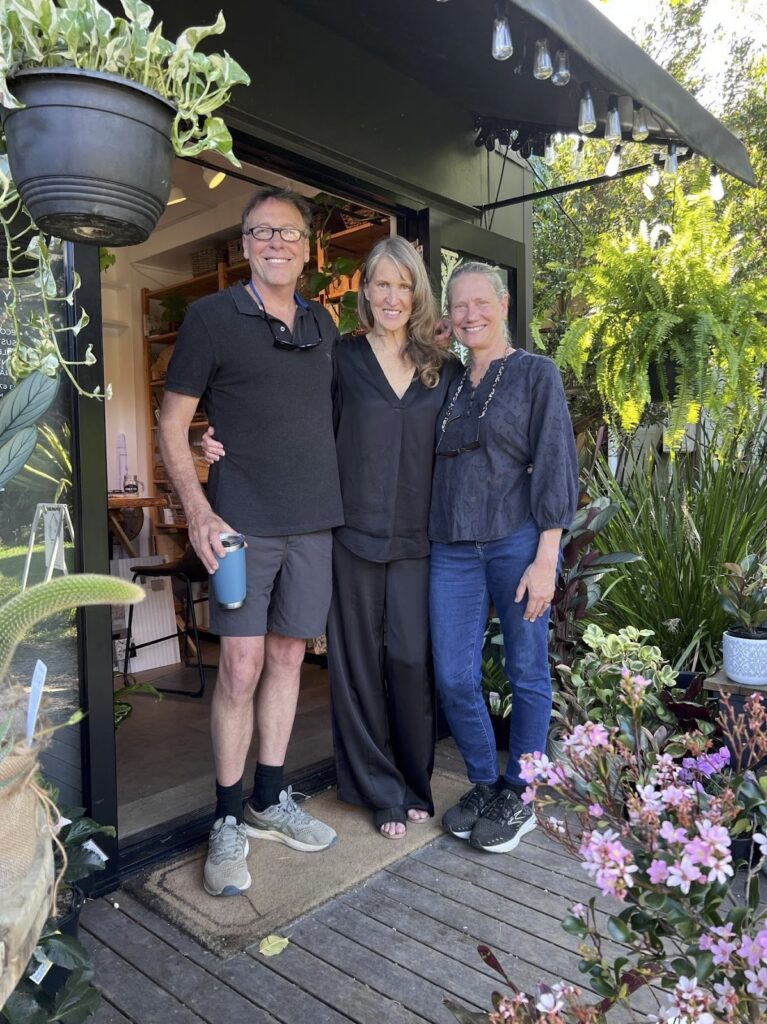
Whilst on route from Brisbane to Bangalow we visited the Currumbin Ecovillage (CEV), which we’ve been wanting to visit since it started 19yrs ago! We were very lucky to meet up and have a tour with CEV in-house selling agent, Kym O’Connell and she kindly introduced us to several residents, one of the founders, as well as some of the operators of the businesses within Ground, the commercial hub in the Ecovillage.
Located in the very picturesque Currumbin Valley, 8km inland from their very beautiful, but busy and built out, coastline. The original property is 111 hectares (275 acres), which is a very similar size to the Witchcliffe Ecovillage (WEV) at 119Ha (294ac).
Interestingly both properties started out as dairy farms. However, that’s about where the similarities of the original farms finish!
The CEV property is very undulating. Stage 1 (Creek Ecohamlets – 45 lots) was built on the valley floor, and the remaining 2 stages (Valley Terraces – 58 lots & Highlands – 38 lots) step up and over the hill, which is 100 metres above the valley floor. As you all know, other than Clusters 4B & 5B, WEV is fairly flat. WEV is located at the very top of its catchment, whereas the Currumbin Valley starts a fair way up from CEV. As such CEV had to design for some serious stormwater flows through the Currumbin Creek (would be called a river in WA!)
While they started out with very similar environmental, social and economic objectives as we did, it’s very different to the Witchcliffe Ecovillage, in many ways.
Due to the amount of undulation, there is a lot of separation between the three stages, and only stage 1 has good pedestrian access to the heart of the village, which is definitely where I would want to live if we lived in CEV. However, other than making the valley floor/stage 1 a lot higher density, they really didn’t have other options, and I’m sure many enjoy the magnificent views and relative isolation of the higher stages.
They have a lot less lots – totaling 141 residential and 6 commercial (less than half of WEV’s), and as such the residential lots are a lot larger, ranging from 450m – 6000m2 and averaging around 2000m2, whereas WEV’s range from 300m2 – 1800m2 and average around 700m2.
CEV has approximately 470 residents, including 350 adults and 120 children (averaging 3.3ppl/home), whereas WEV will end up with around 750 residents (averaging 2ppl/home). Whilst we have a similar proportion of adults and children, our relative affordability and smaller average lot and house size has enabled many single person homes.
The residential lots in both Ecovillages cover a similar percentage of the total property; around 20%. This compares to around 70% in standard residential subdivisions (with around 10% POS & 20% road reserves).
CEV’s lots are priced significantly higher than ours (due to having half the amount of lots, which are more spread out over high cost terrain (for civil infrastructure); not to mention significantly higher land values, starting out from $300,000 in 2005. WEV’s started from $115,000 in 2020. With over 95% of CEV’s lots built on, vacant lots rarely come to market. The last one to sell was 1200m2 for $1,000,000. House and land sales in CEV are around $1.9M.
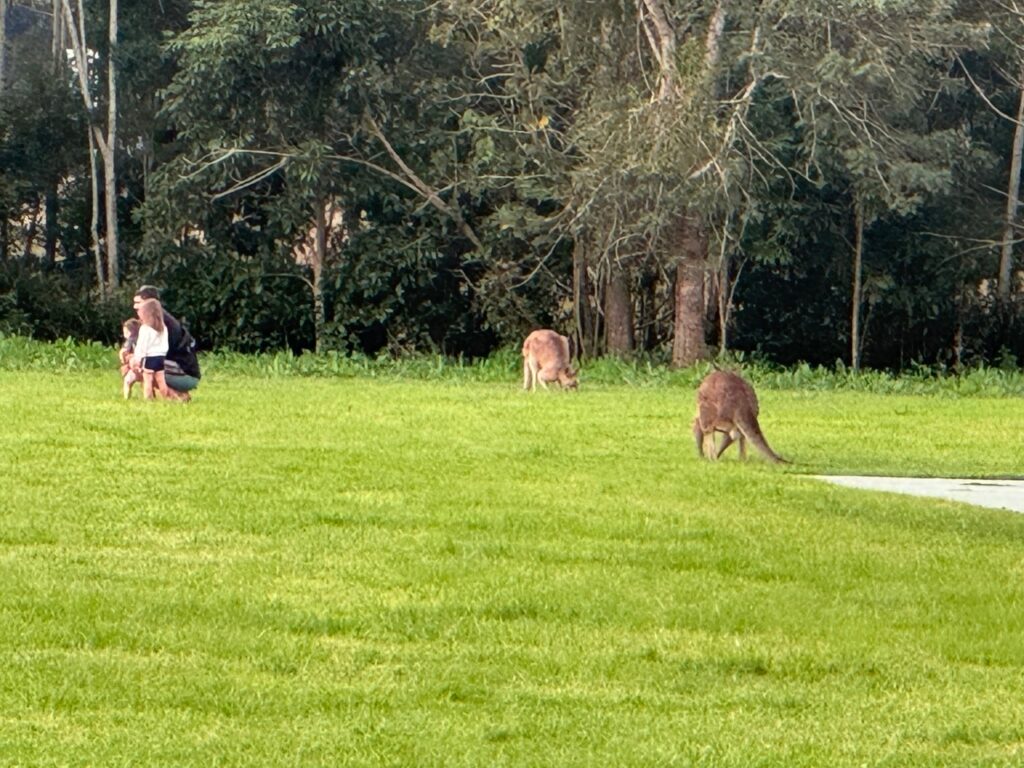
Of CEV’s 141 lots, 24 were limited to 1-2 bedrooms, which did create a more affordable option than their average, but they are very expensive compared to our 55 groupie lots, which were developer subsidised. The remainder of the CEV lots are suitable for up to 6 bedrooms, whereas WEV also provided a mid-priced house and land option (Cottage Lots) that cater predominantly for 3 bedroom homes.
There is also a significant difference in strata fees, as WEV is very much community managed and maintained, with large natural dams for swimming, whereas CEV has two full-time gardeners and a swimming pool. WEV’s average annual strata fees are around $1,100/home, which is very low considering the huge amount of amenity and shared infrastructure (which includes batteries that basically provide for net $0 energy costs for most homes) and CEV’s are around $9,000pa. As such, WEV’s land and strata costs enable a larger diversity of financial circumstances, though one has to remember that land values are a lot higher on the east coast in general.
Both CEV and WEV elected not to pursue scheme water connections, due to the high carbon footprint and preference to avoid chlorinate, so all homes are serviced by independent rainwater tanks. Both have provided deep sewer and on-site community scale wastewater treatment plants. CEV & WEV are both connected to electricity grids, but WEV has gone a lot further in terms of mandating minimum size solar installations and providing community scale micro-grids and batteries. In this case, WEV benefitted from significant improvements and cost reductions with both solar and batteries, due to being planned and developed later than CEV.
Both WEV & CEV have provided considerable community owned conservation land, but CEV hasn’t had to provide dams for irrigation due to the higher rainfall. Therefore, all of their stormwater ends up in the creek, though nicely filtered through constructed wetlands.
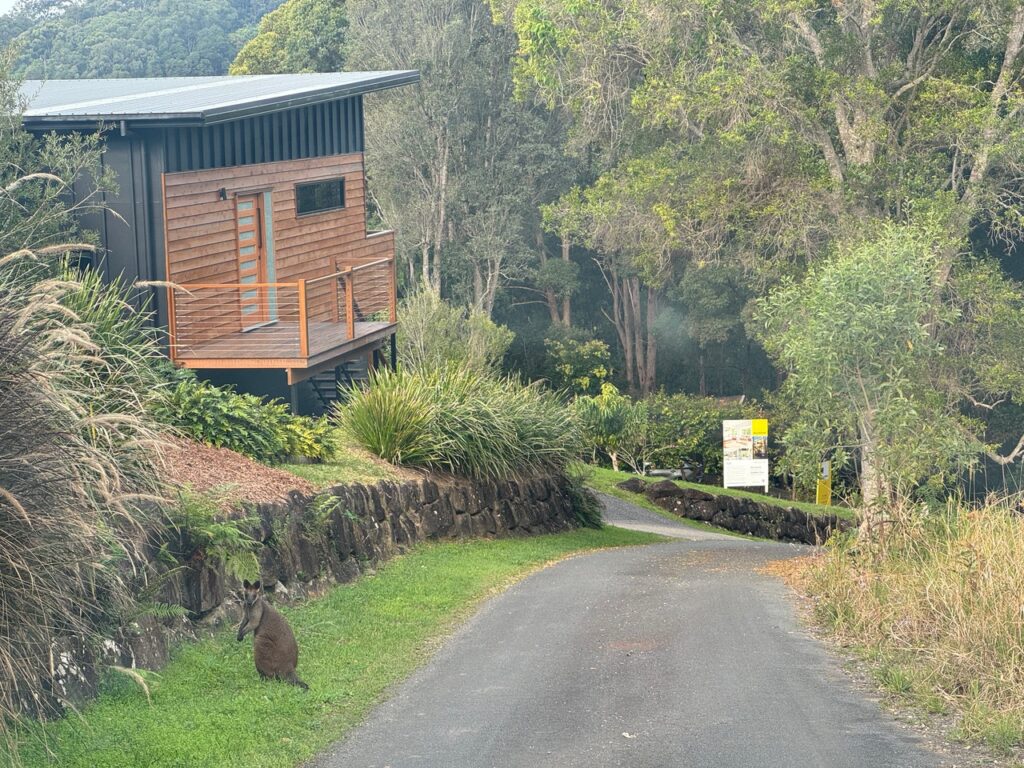
Brush Tailed Wallaby at Currumbin Ecovillage
Whilst neither allow cats, one of the biggest differences between the two ecovillages is that CEV also doesn’t allow dogs, and as such they also don’t need/allow fencing between lots. This enables a quite remarkable outcome where native animals are free to roam through, and live in, the village! It was such a delight to see Brush-Tailed Rock-Wallaby’s, now rare in NSW, at home and protected in CEV. We also saw quite a few Eastern Grey Kangaroos, grazing and lounging around.
As someone that has basically had a dog companion every year of my life, I have to say I was surprisingly pleased to experience this. I also realised that while the wallabies and roos were visibly present, there would have been many other animals, including reptiles and nocturnal marsupials, also flourishing within CEV because of this brave initiative from the developer.
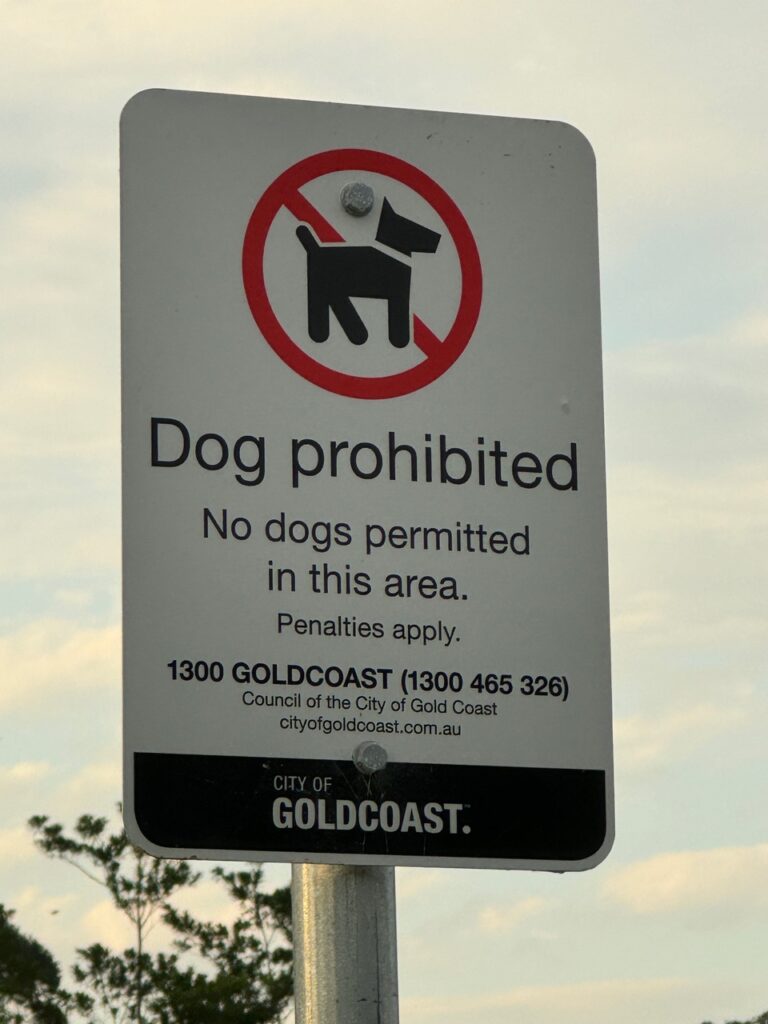
Whilst we don’t allow cats in WEV, which has only cost us a handful of sales, I think we’d still be trying to sell lots in Stage 1 if we didn’t allow dogs, which is why I called it a brave initiative. It was wonderful to hear that all of the builders and tradespeople employed at CEV over the years had respected the no dog rule as well.
Currumbin Ecovillage signage
I was asked what our current average building rate per m2 is, to which I replied around $4,500. To my surprise they replied, gee that’s excellent, ours is currently over $6,000! Their building costs have also increased considerably since the stimulus grants and other Covid related inflation.
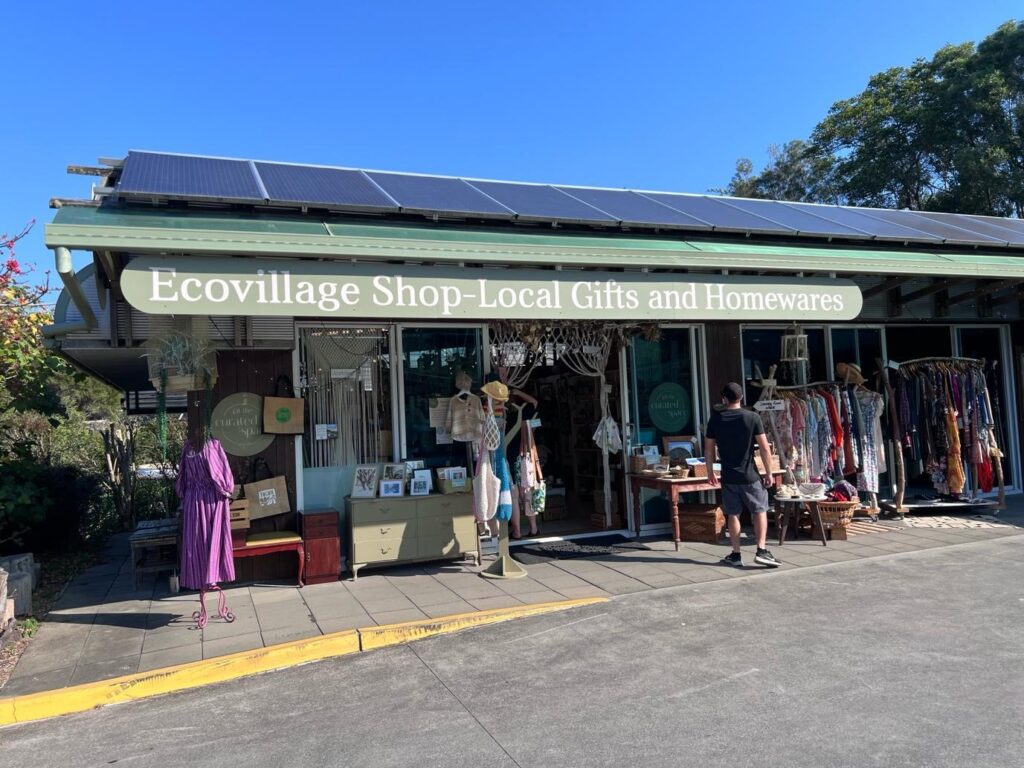
CEV has a lovely little commercial area, called “Ground,” similar to our Village Square, which includes a wonderful restaurant/café called Pasture & Co, along with a really lovely health food shop, Ground Grocer, which sells organic fruit & veg, seeds, grains, health food products and a café using all organic produce. There’s also a Bath House in a beautiful garden setting.
We enjoyed experiencing each of these businesses and were generously gifted a session in the Bath House due to our efforts in founding WEV! The Bath House is predominantly built outdoors, under a massive native Ficus (the size of a large Morton Bay Fig tree) which was absolutely delightful.
Interestingly, the commercial precinct at CEV took many years to come out of the ground, and the mixed use lots have only recently started construction. The health food store started as a Saturday stall, and then operated out of a shipping container for a couple of years before their beautiful shop was built by one of the founding partners in the project.
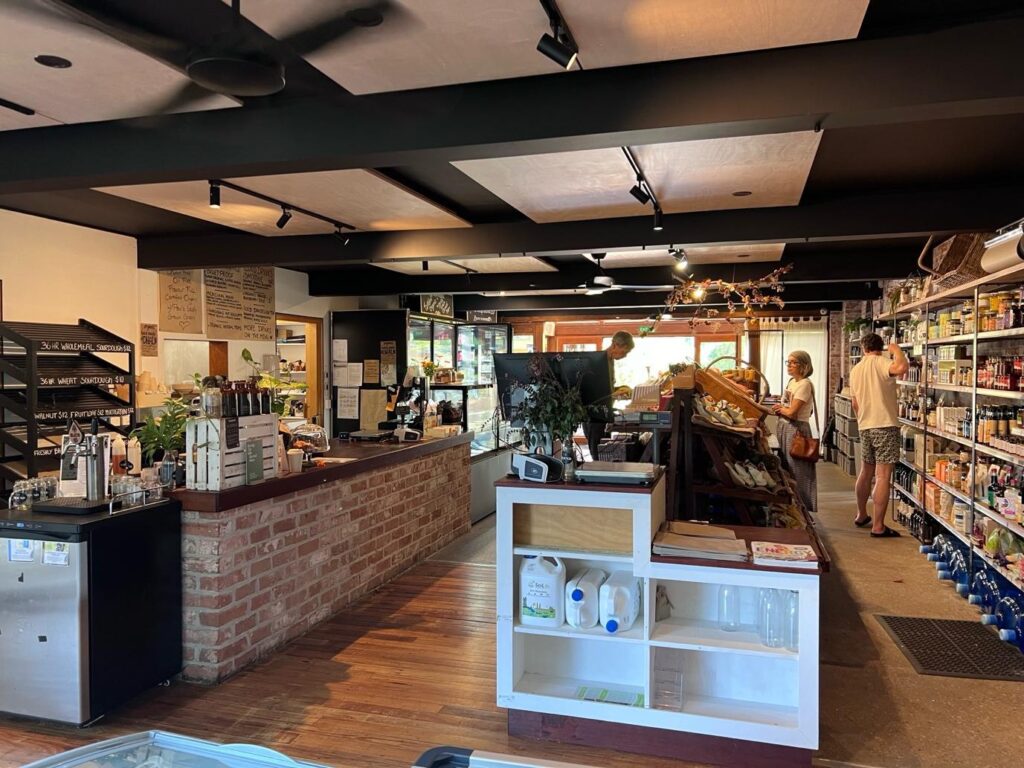
Overall, we were very impressed with the Currumbin Ecovillage! The founders made a huge effort to create an exemplary model of a sustainable human settlement, in a truly magnificent location. If I was moving to SE Queensland, and our dear old dogs had passed on, there’s no doubt that we’d have our name down for a home in CEV (don’t tell Conto or Marri that I said that!)
